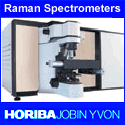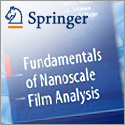Scientists at Yokohama National University in
Japan have built a highly efficient
room-temperature nanometer-scale laser that
produces stable, continuous streams of
near-infrared laser light. The overall device has
a width of several microns (millionths of a
meter), while the part of the device that actually
produces laser light has dimensions at the
nanometer scale in all directions. The laser uses
only a microwatt of power, one of the smallest
operating powers ever achieved. This nanolaser
design should be useful in future miniaturized
circuits containing optical devices. The
researchers present their nanolaser in the latest
issue of Optics Express, an open-access journal
published by the Optical Society of America.
The laser is made of a semiconductor material
known as gallium indium arsenide phosphate
(GaInAsP). The laser's small size and efficiency
were made possible by employing a design, first
demonstrated at the California Institute of
Technology in 1999, known as a photonic-crystal
laser. In this design, researchers drill a
repeating pattern of holes through the laser
material. This pattern is called a photonic
crystal. The researchers deliberately introduced
an irregularity, or defect, into the crystal
pattern, for example by slightly shifting the
positions of two holes. Together, the photonic
crystal pattern and the defect prevent light waves
of most colors (frequencies) from existing in the
structure, with the exception of a small band of
frequencies that can exist in the region near the
defect.
By operating at room temperature and in a mode
where laser light is emitted continuously, the new
nanolaser from Yokohama National University
distinguishes itself from previous designs. For a
laser device that depends on the delicate effects
of quantum mechanics, the random noise associated
with even a moderately warm environment usually
overwhelms the process of producing laser light.
Yet this laser operates at room temperature. It
also produces a continuous output of light, rather
than a series of pulses. This desirable continuous
operation is more difficult to achieve because it
requires careful management of the device's power
consumption and heat dissipation.
According to Yokohama researcher Toshihiko
Baba, the new nanolaser can be operated in two
modes depending what kind of "Q" value is chosen.
Q refers to quality factor, the ability for an
oscillating system to continue before running out
of energy. A common example of an oscillating
system would be a tuning fork. The higher its Q
value, the longer it will ring after being struck.
Lasers are oscillating systems because they
produce light waves that repeatedly bounce back
and forth inside the device to build up a beam.
Nanolasers operated in a high-Q mode (20,000) will
be useful for optical devices in tiny chips
(optical integrated circuits). In a moderate-Q
(1500) configuration the nanolaser needs only an
extremely small amount of external power to bring
the device to the threshold of producing laser
light. In this near-thresholdless operation, the
same technology will permit the emission of very
low light levels, even single photons.
Posted 21st June 2007











